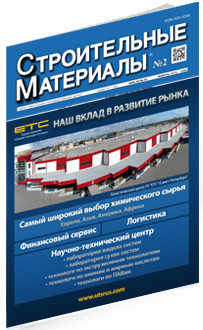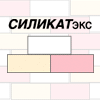Stroitel`nye Materialy №2

February, 2013
Table of contents
V.G. KHOZIN, Doctor of Technical Science, I.A. STAROVOITOVA, N.V. MAISURADZE,
Candidates of Technical Sciences, E.S. ZYKOVA, R.A. KHALIKOVA, engineers, Kazan
State university of architecture and construction; A.A. KORZHENKO, Candidate of Technical
Sciences, Research Center of ARKEMA (France); V.V. TRINEEVA, Candidate of Technical
Sciences, Institute of Mathematics and Mechanics of Ural Division of RAS (Izhevsk);
G.I. YAKOVLEV, Doctor of Technical Sciences, Izhevsk State Technical University named after
M.T. Kalashnikov
In the present research regularities of influence of modification additives on technological and operational properties
of polymer binders are presented. The nano-modification of two different kinds of binders for polymer
composite reinforcement – epoxy and hybrid (organic-inorganic) binders, led to a sensible rise of major performance
features as strength, adhesion, thermal resistance at ultra-low loading of modifying agent – carbon
nanoparticles. At the same time, the regularities of nano-modification display in the extremal dependences.
Keywords: polymer composite reinforcement, epoxy binders,
hybrid organic-inorganic binders, nano-modification, compression
strength, thermal resistance.
V.V. NELUBOVA, Candidate of Technical Sciences, V.V. STROKOVA, Doctor of Technical Sciences,
N.V. PAVLENKO, Candidate of Technical Sciences, I.V. ZHERNOVSKY, Candidate of Geological
and Mineralogical Sciences, Belgorod State Technological University named after V.G. Shoukhov
The evolution of nanostructured binder was described in the article. It is noted that applying of the binder in production
of construction materials allows improving basic operational properties of different purpose materials.
Keywords: nanostructured binder, aerated concretes, structurization,
autoclave materials.
V.V. STROKOVA, Doctor of Technical Sciences, I.V. ZHERNOVSKY, Candidate of Geological
and Mineralogical Sciences, Y.N. OGURTSOVA, engineer, A.V. MAKSAKOV, engineer,
Belgorod State Technological University named after V.G. Shoukhov
Basic principles of raw selection to design granulated nanostructuring aggregate are considered in this
article. Modification mechanism of cement matrix with Na polysilicate solution is also described.
Concrete mixtures on the base of granulated nanostructuring aggregate.
Keywords: silica raw material, granulated nanostructuring
aggregate, light-weight concrete.
N.V. PAVLENKO, A.B. BUKHALO, Candidates of Technical Sciences, V.V. STROKOVA, Doctor
of Technical Sciences, V.V. NELUBOVA, Candidate of Technical Sciences, A.V. SUMIN, engineer,
Belgorod State Technological University named after V.G. Shoukhov
Some features of the binder modification with nanocrystalline components as crystallization centers and
components intensified a growth of hydrate formations with regular prismatic and hexagonal shape are
described. This provides the reduction of defectiveness and enhances a strength values of based materials.
Keywords: binder, fine powder, nanocrystalline, modifier, strength.
G.I. YAKOVLEV, Dr., G.N. PERVUSHIN, Doctors of Technical Sciences, Izhevsk Kalashnikov
State Technical University (Russia); A. KORZHENKO, Candidate of Technical Sciences,
Groupement de Recherche de Lacq, «Arkema» (France);
A.F. BURYANOV, Doctor of Technical Sciences, National Research University Moscow State
University of Civil Engineering; JA.К. KERIENE, Dr., Vilnius Gediminas Technical University,
(Lithuania); I.S. MAEVA, Doctor of Technical Sciences, D.R. CHAZEEV, master, I.A.PUDOV,
engineer, Izhevsk Kalashnikov State Technical University; S.A. SENKOV, Candidate of Technical
Sciences, State National Research Politechnical University of Perm (Russia)
The research has been conducted regarding the influence of multi-walled carbon nanotubes (MWCNTs) dispersions on the structure of crystalhydrate neoformations in interporous walls of autoclaved cellular concrete. The performed research of the microstructure of calcium hydrosilicates formed at autoclave treatment of silicate cellular concrete modified with MWCNT which led to the enhancement of physical and technical properties of autoclaved cellular concrete. Keywords: multi-walled carbon nanotubes, autoclaved cellular concrete, calcium hydrosilicates, morphology of neoformations.
The research has been conducted regarding the influence of multi-walled carbon nanotubes (MWCNTs) dispersions on the structure of crystalhydrate neoformations in interporous walls of autoclaved cellular concrete. The performed research of the microstructure of calcium hydrosilicates formed at autoclave treatment of silicate cellular concrete modified with MWCNT which led to the enhancement of physical and technical properties of autoclaved cellular concrete. Keywords: multi-walled carbon nanotubes, autoclaved cellular concrete, calcium hydrosilicates, morphology of neoformations.
E.V. KOROLEV, Doctor of Technical Sciences, director of SEC «Nanotechnologies»,
A.N. GRISHINA, Candidate of Technical Sciences,
Moscow State University of Civil Engineering
The results of a new method for the synthesis of silicic acidis offered, its stability was investigated. A new nanoscale modifier based on a system containing
two types of nanoparticles to enhance the stability of foams is considered.
Keywords: nanoparticles, sol of iron hydroxide, silica sol,
sol forming, foam, stability.
А.F. GORDINA, master, Yu.V. TOKAREV, Candidate of Technical Sciences,
G.I. YAKOVLEV, Doctor of Technical Sciences, Izhevsk State Technical University
named after M.T. Kalashnikov (Russia); Ya. KERIENE, Doctor of Technical Sciences,
E. SPUDULIS, Doctor- engineer, Vilnius Gediminas Technical University (Lithuania)
The differences in forming the structure of gypsum binder using multilayer carbon nanostructures and lime introduced together and separately are
found, and their influence on mechanical properties is defined.
Keywords: gypsum binder, multilayer carbon nanotubes,
lime, microstructure.
M.S. GARKAVI, Doctor of Technical Sciences; S.A. NEKRASOVA, engineer; E.A. TROSHKINA, Candidate of Technical Sciences, Magnitogorsk State Technical University
Kinetics of formation of inter-particle contacts in the gypsum materials is researched on the basis of the system of the model quasireactions. It is shown that the introduction of nano-sized components in the gypsum dispersion results in the change of the kinetics of formation of coagulation and coagulation-condensation contacts.Keywords: kinetics, contact, nano-sized component, gypsum dispersion
A.V. SHAIBADULLINA, master, G.I. YAKOVLEV, Doctor of Technical Sciences, V.S. BURDIN, bachelor, Izhevsk State Technical University after by M.T. Kalashnikov A significant change in the structure of silicate paint has been achieved due to its modification with multi-walled carbon nanotubes.
The developed silicate coating has shielding properties for providing comprehensive protection of hardware and a human in industrial, administrative and residential buildings from the influence of electromagnetic fields and protection of a human from pathogenic radiation of the environment. It does not require the use of traditional hardners in the form of zinc oxide. Keywords: multi-walled carbon nanotubes, liquid glass, Portland cement, modifying, shielding, electromagnetic radiation.
M. MORSY, S.A. ELKHODARY, S.S. SHEBL, Housing & Building National Research Center, (Cairo, Egypt)
This paper investigates the development of arc discharge ARCD technique in order to synthesis thermally stable CNTs. The method consists initially of the removal of fullerenes and soluble impurities, followed by liquid-phase oxidation of amorphous carbon. Then, an acid treatment to remove the unprotected metallic particles was finally affected. The results showed that the purified CNTs sample is thermally stable up to 645oC. The thermal stability of CNTs depends on the defects on the side walls and impurities in the purified sample and it can be attributed to efficient cooling system used in the apparatus.
G.D. FEDOROVA, A.E. SAVVINA, Candidates of Technical Sciences, North-Eastern Federal University of M.K. Ammosov; G.I. YAKOVLEV, Doctor of Technical Sciences, I.S. MAEVA, Candidate of Technical Sciences, Izhevsk State Technical University of M.T. Kalashnikov; S.A. SENKOV, Candidate of Technical Sciences, Perm State National Research Polytechnic UniversityResults of researches are presented in this work according to the multifunctional modifier of PFM-NLKconcretes surfactant at carbon nanotubes dispersion.
Technologies of reception of dispersion multiwalled carbon nanotubes are considered. It is shown that efficiency of modifying of concrete carbon nanotubes appreciably depends on quality of dispersion at the moment of inclusion into concrete mix. Keywords: multiwalled, carbon nanotubes, surfactant, dispersion, technology, concrete, a cement matrix, a microstructure.
A.A. SEMENOV, Candidate of Technical Sciences, General Director, OOO “GS-Expert” (Moscow)
Results of Development of Building Complex and Construction Materials Industry in 2012, the forecast for 2013 Keywords: work results in 2012, construction, construction materials industry, macroeconomic data, rates of growth, dynamics of production, stagnation, forecast.
Results of Development of Building Complex and Construction Materials Industry in 2012, the forecast for 2013 Keywords: work results in 2012, construction, construction materials industry, macroeconomic data, rates of growth, dynamics of production, stagnation, forecast.
In 1993 the German family company “KNAUF” purchased a share package of the Thermo-Insulating and Gypsum Materials Complex near Moscow. From this time the history of the company «KNAUF» in Russia began. However, scientific and business relations between the company and the Russian scientific community started to take shape in the 1970s, when the regular exchange of experience with leading research institutes was established, and in the end of 1970 the representative office of “KNAUF Engineering” Co. was open.
G.I. GRINFELD, Executive Director, National Association of Autoclave Gas Concrete Manufacturers (Saint Petersburg)
Production of Autoclave Gas Concrete in Russia: State of Market and Prospects of Development
During the last ten years the total volume of construction in Russia has grown more than twice and reached 97 mil m² in 2012. It was accompanied by essential structural changes: the share of individual and low-rise construction increased, the share of industrial construction reduced, constructive decisions changed. Total volume of the market of piece wall materials increased by 1.5 time. (from 15 up to 21 mil m³)
Ya.I. ZELMANOVICH, Candidate of Chemical Sciences, Director, NTTS “Gidrol-Krovlya” (Moscow)
Market of Roll Bituminous Materials: Preliminary Results of 2012
At the end of January 2013 the Rosstat (Federal State Statistics Service) published preliminary data on the work of branches of the Russia’s economy in 2012. Later on, the results of work will be clarified, however already now it is possible to bring preliminary results of activity in the sectors and sub-sectors of the industry, including the industry of roofing and waterproofing materials.
Market of Roll Bituminous Materials: Preliminary Results of 2012
At the end of January 2013 the Rosstat (Federal State Statistics Service) published preliminary data on the work of branches of the Russia’s economy in 2012. Later on, the results of work will be clarified, however already now it is possible to bring preliminary results of activity in the sectors and sub-sectors of the industry, including the industry of roofing and waterproofing materials.
V.A. DUBOV, Doctor of Economic Sciences, ZAO “Volgotsemservis” (Tolyatti, Samara Oblast); A.A. ZHURAVLEV, President, Association “Nedra” (Moscow); A.S. KNYAZEV, D.Yu. KOPYLOV, Candidates of Technical Sciences, ZAO “Volgotsemservis”
Environment Friendly Technologies of Production of Construction Materials of MMT Type Equipped with Separators of Dynamic Type Ensuring the Grinding and Drying of Starting Material up to 50%
The technology of processing of chippings of carbonate rocks crushing into mineral powder for asphalt concrete, flour for manufacture of mixed feed for animals and poultries as well as fillers for dry mixes is considered. The technology is based on the use of hammer mills. Keywords: mineral powder, limestone flour to fatten chickens and animals, chippings of carbonate rocks crushing, hammer tangential mill, grinding, drying
The technology of processing of chippings of carbonate rocks crushing into mineral powder for asphalt concrete, flour for manufacture of mixed feed for animals and poultries as well as fillers for dry mixes is considered. The technology is based on the use of hammer mills. Keywords: mineral powder, limestone flour to fatten chickens and animals, chippings of carbonate rocks crushing, hammer tangential mill, grinding, drying
N.M. SERGINA, D.V. AZAROV, Candidates of Technical Sciences, the Volgograd State University of Architecture and Civil Engineering; E.V. GLADKOV, President, OOO Tashlinskiy GOK, Ulyanovsk Oblast
System of Inertial Dust Catching in Construction Materials Industry
It is shown, that the use of the offered systems of dust catching with inertial devices with counter current vortex flows makes it possible to ensure efficiency of dust removal within 84-98.2%.
Keywords: systems of dust catching, inertial dust catchers, scrubbers, dust catchers VZP
L.A. VAYSBERG, Doctor of Technical Sciences, Corresponding Member of RAS, K.S. IVANOV, scientific officer, “Mechanobr-Tekhnika” Research and Engineering Corporation (Saint Petersburg)
New Methods for Modeling Vibrating Screens
On the basis of a new approach to the modeling of screening process the program for selecting the optimal combination of technological and constructive parameters of devices for separation of bulk materials according their sizes has been developed.
 |
 |
 |
 |
 |
 |

